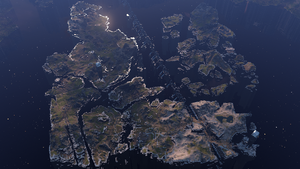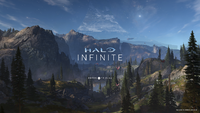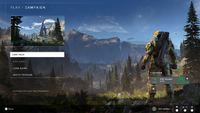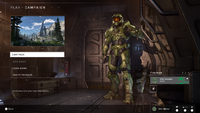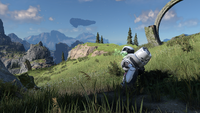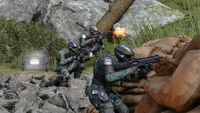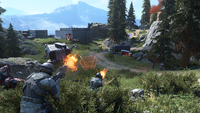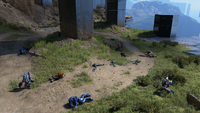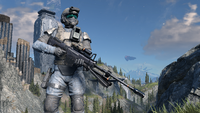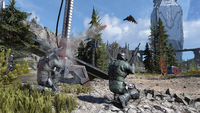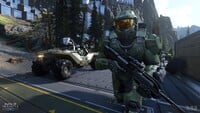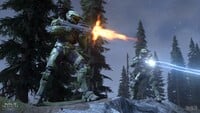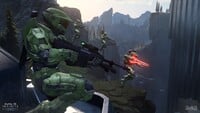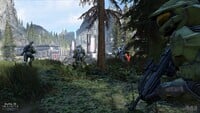User:JackVibe/Sandbox
From Halopedia, the Halo wiki
| Zeta Halo | |
|---|---|
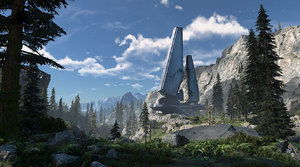
| |
|
Game: |
|
|
File name (?): |
|
|
Player: |
|
|
Date: |
|
|
Location: |
|
 |
Halopedia doesn't currently have a walkthrough for this level; could you write one? |
| “ | Unravel the mysteries of Zeta Halo through Solo or Co-Op play. | ” |
Zeta Halo is the open world map for Halo Infinite's campaign, doubling as the hub world for all main and side missions.[2][3][4]
Universe and lore
- Main article: Installation 07
Halo Infinite campaign is set on the fragmented section of Installation 07, save for the first mission Warship Gbraakon, which is set onboard the Banished dreadnought Ghost of Gbraakon. On December 12, 2559, during the opening stages of the Battle for Zeta Halo, in an attempt to prevent Atriox from accessing the Silent Auditorium or activating the ring, Created Archon Cortana initiated a local self-destruction sequence from the ring. The process killed Cortana and left the local land mass fragmented.[5][6] Over the next six months, while the ring repaired itself,[7] the scattered survivors UNSC forces from UNSC Infinity staged a resistance against the Banished, but the Banished forces ultimately gained an upper hand.[5] The Master Chief was awakened on May 28, 2560,[1] and followed the Weapon's signal to the fragmented region of the ring.[1]
Areas
The campaign overworld is composed of seven areas; each corresponding to a narrative arc. Access to each area is unlocked after a particular main mission.
The seven areas and their missions are as follows:
| Areas | Main missions | Banished outposts | Forward Operating Bases | UNSC distress calls | High Value Targets |
|---|---|---|---|---|---|
| Ringfall | N/A | N/A | N/A | N/A | |
| Lockdown | |||||
| Connections | |||||
| Graveyards | N/A | N/A | N/A | N/A | |
| Reformation | |||||
| Reckoning | N/A | N/A | N/A | N/A | |
| Endless | N/A | N/A | N/A | N/A |
Ringfall
Ringfall is a linear section in the opening of the campaign, composed of the first three campaign levels: Warship Gbraakon, Foundation, and Outpost Tremonius.
Lockdown
Connections
Graveyards
Reformation
Reckoning
Endless
List of missions
Main missions
| Main missions | |||
|---|---|---|---|
| Name | Area | Description | |
 Warship Gbraakon |
Ringfall | Board the Banished ship, locate the bridge and disable whatever hit the Pelican. | |
 Foundation |
Ringfall | Look for a weapon in the broken section of the Halo. | |
 Outpost Tremonius |
Ringfall | Explore the Banished base and discover their motives. | |
 Recovery |
Lockdown | Investigate the UNSC distress signal. | |
 Excavation Site |
Connections | Griffin's intel suggests that the Banished are looking for something at this excavation site. Investigate and disrupt. | |
 Conservatory |
Connections | The Banished are searching for something called The Conservatory, which is buried deep within the Halo. Enter it and discover its true purpose. | |
 Spire |
Connections | Pursue the Harbinger into this mysterious Forerunner structure. | |
 Pelican Down |
Graveyards | Eliminate the Banished gun batteries to escape the island and continue your pursuit of the Harbinger. | |
 The Sequence |
Reformation | Reconstruct the Forerunner sequence at each of the four beacons to gain access to the Command Spire. | |
 Nexus |
Reformation | Enter the Nexus and discover its true purpose. | |
 The Command Spire |
Reformation | Shut down the rest of the Spires. | |
 Repository |
Reckoning | Escharum has kidnapped The Pilot. The Weapon opened a gate for you to follow him. It took you to this mysterious location. | |
 The Road |
Reckoning | Pursue the Pilot to the House of Reckoning. | |
 House of Reckoning |
Reckoning | Confront Escharum at the House of Reckoning. | |
 Silent Auditorium |
Endless | Confront the Harbinger at the Silent Auditorium and finish the fight. | |
Side missions
Banished Outposts
| Banished outposts | |||
|---|---|---|---|
| Name | Area | Description | Rewards |
 Ransom Keep |
Lockdown | Primarily operated by Banished-loyal Sangheili warriors, this outpost's primary function seems to be related to the appropriation of UNSC materials. | 100 Valor |
 Armory of Reckoning |
Connections | Traffic patterns and battlenet chatter suggest that this large and well-fortified depot is an integral component of Banished supply lines in this region. | 100 Valor |
 Forge of Teash |
Connections | The purpose of this Banished outpost is yet unclear, but its significant energy consumption and thermal footprint indicate some critical function in Escharum's operations on Zeta Halo. | 100 Valor |
 Horn of Abolition |
Connections | Intercepted signal telemetry suggests this Banished outpost may serve a vital function in their communications and tracking operations. | 100 Valor |
 Redoubt of Sundering |
Connections | Scattered reports from UNSC field operatives identify this outpost as a processing site for imprisoned UNSC personnel. To what ultimate end is unknown. | 100 Valor |
 Annex Ridge |
Reformation | Recon reports from Spartans Jaide and Rosado have revealed peculiar Banished activity concerning the excavation of ancient and enigmatic artifacts. | 100 Valor |
 Riven Gate |
Reformation | The Banished have constructed a massive gate structure in order to control primary transportation routes across this section of the Ring fragment. | 100 Valor |
UNSC distress calls
| UNSC distress calls | |||
|---|---|---|---|
| Name | Area | Description | Rewards |
 Boxer Squad |
Lockdown | Distress call received from Boxer Squad. Rendezvous at their position immediately to provide assistance. | 30 Valor |
 Carrera Squad |
Lockdown | Carrera call received from Carrera Squad. Rendezvous at their position immediately to provide assistance. | 30 Valor |
 Cayman Squad |
Lockdown | Distress call received from Cayman Squad. Rendezvous at their position immediately to provide assistance. | 30 Valor |
 Starlight Squad |
Lockdown | Distress call received from Starlight Squad. Rendezvous at their position immediately to provide assistance. | 30 Valor |
 Barracuda Squad |
Connections | Distress call received from Barracuda Squad. Rendezvous at their position immediately to provide assistance. | 30 Valor |
 Bengal Squad |
Connections | Distress call received from Bengal Squad. Rendezvous at their position immediately to provide assistance. | 30 Valor |
 Bluebell Squad |
Connections | Distress call received from Bluebell Squad. Rendezvous at their position immediately to provide assistance. | 30 Valor |
 Cobra Squad |
Connections | Distress call received from Cobra Squad. Rendezvous at their position immediately to provide assistance. | 30 Valor |
 Courier Squad |
Connections | Distress call received from Courier Squad. Rendezvous at their position immediately to provide assistance. | 30 Valor |
 Foxhound Squad |
Connections | Distress call received from Foxhound Squad. Rendezvous at their position immediately to provide assistance. | 30 Valor |
 Harpoon Squad |
Connections | Distress call received from Harpoon Squad. Rendezvous at their position immediately to provide assistance. | 30 Valor |
 Indiana Squad |
Connections | Distress call received from Indiana Squad. Rendezvous at their position immediately to provide assistance. | 30 Valor |
 Jester Squad |
Connections | Distress call received from Jester Squad. Rendezvous at their position immediately to provide assistance. | 30 Valor |
 Lancer Squad |
Connections | Distress call received from Lancer Squad. Rendezvous at their position immediately to provide assistance. | 30 Valor |
 Paladin Squad |
Connections | Distress call received from Paladin Squad. Rendezvous at their position immediately to provide assistance. | 30 Valor |
 Pronto Squad |
Connections | Distress call received from Pronto Squad. Rendezvous at their position immediately to provide assistance. | 30 Valor |
 Pyramid Squad |
Connections | Distress call received from Pyramid Squad. Rendezvous at their position immediately to provide assistance. | 30 Valor |
 Thunder Squad |
Connections | Distress call received from Thunder Squad. Rendezvous at their position immediately to provide assistance. | 30 Valor |
 Titan Squad |
Connections | Distress call received from Titan Squad. Rendezvous at their position immediately to provide assistance. | 30 Valor |
 Fortune Squad |
Reformation | Distress call received from Fortune Squad. Rendezvous at their position immediately to provide assistance. | 30 Valor |
High Value Targets
| High Value Targets | |||
|---|---|---|---|
| Name | Area | Description | Rewards |
Collectibles
Mjolnir Armory
- Main article: Mjolnir Armory
Audio logs
- Main article: HINF:Audio log
Propaganda towers
- Main article: Propaganda tower
Skulls
- Main article: Halo Infinite skulls
Spartan core
- Main article: Spartan core
Production notes
Gallery
Menu
Screenshots
Sources
- ^ a b c Halo Infinite Campaign Gameplay Premiere
- ^ Halo Waypoint, Inside Infinite - February 2021 (Retrieved on Mar 28, 2021) [archive]
- ^ Halo Support, Halo Infinite Support Glossary: "Zeta Halo: One of the seven rings in the Halo Array and the location of the Halo Infinite campaign." (Retrieved on Feb 9, 2025) [archive]
- ^ Halo Support, Collectibles in Halo Infinite Campaign (Retrieved on Jun 12, 2024) [archive]
- ^ a b Halo Encyclopedia (2022 edition), page 25
- ^ Halo Infinite, campaign mission Endless: Silent Auditorium: "It was her. She destroyed the Ring. Stopped my deletion." - The Weapon
- ^ Halo Infinite, UNSC Audio log: Reverie #04 - On the Mend
